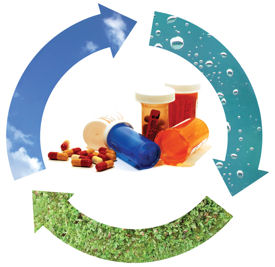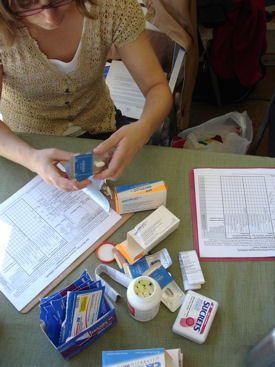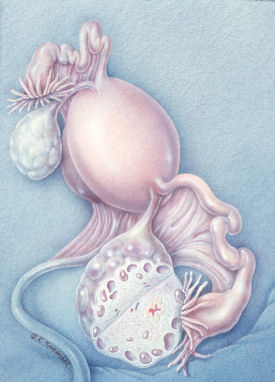Dumping drugs puts traces of meds in taps
How can you keep the contents of one patient's medicine cabinet from getting into everyone's drinking water? Eventually, physicians could even be asked to pay attention to environmental impact when deciding which drugs to prescribe.
Tetracycline, naproxen, prednisone, fluoxetine, bezafibrate, simvastatin, atenolol. These are not the contents of a drug rep's briefcase, nor the medicine cabinet of a chronically ill patient. The listed pharmaceuticals, along with 49 others, were found in tests of Philadelphia drinking water, an Associated Press investigation revealed last year.
News coverage of drug-contaminated water samples in Philadelphia and 24 other U.S. cities has brought public attention to an issue that environmental scientists and green medicine advocates have been working on for a while: How can you keep the contents of one patient's medicine cabinet from getting into everyone's drinking water?

“A lot of medications are not removed in drinking water treatment facilities, so when people flush unused medications down the toilet or even when the medicines pass through the human body, they can come back into the drinking water stream,” said David O. Carpenter, MD, director of the Institute for Health and the Environment at State University of New York at Albany.
The situation should concern internists both because of the potential health impacts of drugs in the water and because practicing physicians are well-placed to do something about the problem, experts said.
A mystery brew
The likely effects of the pharmaceutical remnants on human health are not clear. “In terms of how dangerous it is, we really don't have a very good handle. There haven't been good studies,” said Dr. Carpenter. “We have enough information from animal studies to be concerned that this is something that needs attention.” For example, male fish living near the outflow of waste water treatment plants have been shown to make an egg protein normally found only in female fish.
Of the drugs found in water supplies, Dr. Carpenter is most concerned about antibiotics, which could promote resistance, and estrogenic drugs, which could affect male fetal development when consumed by pregnant women.
He's not happy about the antipsychotics and other drugs uncovered in tests, either. “It isn't quite as obvious that these would pose dangers to human health, but on the other hand, none of us wants to be getting the Prozac our neighbor is excreting,” Dr. Carpenter said.
The Pharmaceutical Research and Manufacturers of America (PhRMA), an advocacy group for the pharmaceutical and biotechnology industries, sees less reason for concern. “The good news is that the studies conducted so far suggest it is highly unlikely that the small amounts of medicine detected in drinking water or the environment would harm human health,” the group said in a statement.

PhRMA has, however, joined a campaign by the U.S. Fish and Wildlife Service to educate consumers about proper disposal of medications. The SMARxT Disposal program promotes the current federal guidelines for drug disposal, which suggest mixing unused medications with coffee grounds or kitty litter, placing them in a sealed container and throwing the mixture out with the trash. (That is except for some controlled substances, which the government still recommends flushing.)
Correcting the conventional wisdom about flushing medications is a major goal of everyone involved in the prescription disposal issue. And there's still a long way to go on that project, according to researcher and family physician Dean A. Seehusen, MD.
In a study published in 2006 in the Journal of the American Board of Family Medicine, he found that more than half of surveyed patients had flushed unused or expired medications down the toilet and less than 20% had ever been given advice about medication disposal by a health care provider.
That's not surprising, given that many health care providers have probably never been given any advice themselves, Dr. Seehusen said. “My sense is that most physicians honestly have never thought about this as a problem. We're just not trained about it.”
Recent news stories have begun to change that dynamic, according to Ilene Ruhoy, MD, PhD, a researcher with the U.S. Environmental Protection Agency (EPA) and the director of Touro University Institute for Environmental Medicine. “Since the topic has been in the mainstream press, physician friends of mine have contacted me to inquire about the issue and things that they can do,” she said.
The first, simplest step that she recommends is for physicians to provide patient education about drug disposal. “At least maybe have some information—pamphlets or brochures that can be given on checkout: ‘If some of your medication goes unused, here's what you can do,’” Dr. Ruhoy said.
Throw out vs. take back
The options for what patients can do with their unused meds are widening. In addition to the new federal disposal guidelines, there are a growing number of pharmaceutical take-back programs. The Teleosis Institute, a nonprofit group, helps pharmacies set up systems to collect patients' unused medications and have the drugs incinerated as medical waste, called the Green Pharmacy Program.
“It's usually something that their customers have asked for. For pharmacies, it increases their foot traffic,” said Evin Guy, green pharmacy program manager for Teleosis.
Yet take-back programs are not a perfect solution to the pharmaceutical disposal problem, said Christian Daughton, PhD, chief of the environmental chemistry branch at the EPA's laboratory in Las Vegas. “The problem with take-back programs is that they aren't sustainable. They're too expensive to run. The problem is primarily generated by controlled substances,” which have to be collected by law-enforcement officials, he said.
Although she expects take-back programs to continue to grow, Ms. Guy doesn't see them as the ultimate answer to the problem, either. Through the take-back programs, the Teleosis Institute has collected data on what kinds of drugs were turned in and why. While a lot of the unused meds stem from consumer habits (jumbo-size containers of expired aspirin), some responsibility also can be traced to physician practices.
“One of the things we're finding is that there is a lot of overprescribing going on,” said Ms. Guy. Drugs go unused because they were ineffective or had side effects that patients couldn't tolerate. “They've taken two pills and maybe they have 50 more,” she said.
Physicians can help reduce the excess, by writing small, trial prescriptions for new medications, but they should not bear the full blame for the problem, noted Dr. Daughton. “Insurers are partly responsible for that because they push for longer supplies,” he said.
Dr. Daughton saw particularly egregious examples of this over-dispensing in a first-of-its-kind study he and Dr. Ruhoy conducted of the disposal practices of a Nevada coroner's office (where all decedents' leftover meds were dumped down the drain). “A patient dies and they're on automatic refill and every three months, a new 90-day supply arrives at the family's residence,” Dr. Daughton said.
Samples are another common way that medication is wasted, according to Charlotte Smith, president of PharmEcology Associates, an environmental consulting firm. “Very often the drugs go out of date and now you've got waste that is very difficult to get rid of,” she said.
The unused medication is problematic not only from the perspective of environmental health, but also from considerations of cost and healthcare effectiveness. “Any drugs that are unused or left over represent wasted healthcare resources and often lost opportunities to treat,” said Dr. Daughton.
The issue of unused samples has the clearest solution, which is to replace the drugs in physicians' offices with vouchers that patients can take to the pharmacy for free medications.
To reduce waste more generally, Dr. Daughton recommends that physicians write scripts for smaller quantities, but also that they communicate more closely with patients about medications. Potential issues with side effects and concerns about the purpose of a medication, which could lead to nonadherence, can be sussed out in these conversations. “A more in-depth discussion between the physician and the patient can go a long way to curbing noncompliance,” Dr. Daughton said.
He acknowledged that this proposal is yet another time demand for already busy practitioners. “We realize that physicians have a lot of other things to do rather than focus on the potential for environmental impact. But when you realize that the potential for environmental impact is intimately intertwined with health care costs and health care outcomes, then it's something they could pay more attention to,” he said.
Eventually, physicians could even be asked to pay attention to environmental impact when deciding which drugs to prescribe. A program recently begun in Sweden instituted new drug labels that identify the relative effects of different medications on the environment. When deciding what drug to prescribe, physicians could use the labels to consider environmental consequences, alongside factors like cost and side effects.
Such a program would go beyond the issue of unused medications to get at the bigger overall problem of pharmaceuticals in the water. Because for all the attention given to drug disposal, unused medications represent only a (probably small, but not easily quantified) part of the problem, experts said. A good chunk of the medication found in the water comes from drugs that are taken, but not fully metabolized before they are excreted.
More intensive water-filtering systems are one potential solution to the problem, but environmental medicine advocates also favor cutting back on prescribing. No one's proposing to empty that chronically ill patient's medicine cabinet yet, but the issue of pharmaceuticals' effects on the environment is not likely to go away.
“As our population ages, as we continue to develop new medications,” said Dr. Seehusen, “we do at some point have to start thinking about, ‘what is the overall impact?’”




